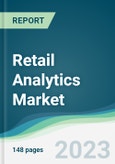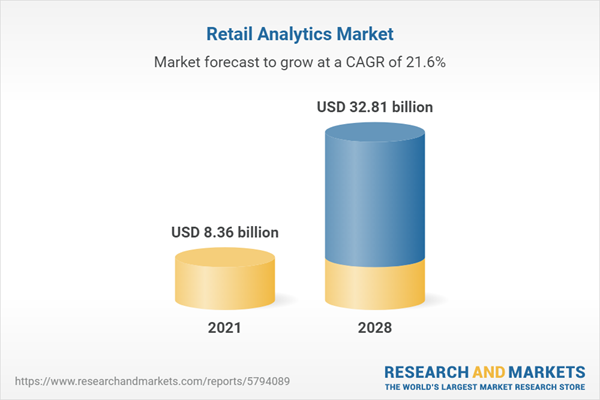The retail analytics market is projected to grow at a CAGR of 21.56% to reach US$32.808 billion in 2028 from US$8.364 billion in 2021.
Retail analytics refers to techniques and tools used to analyze data within the retail industry. This involves collecting, organizing, and analyzing data from various sources, such as sales transactions, inventory levels, customer behavior, and social media interactions. The insights gained from this analysis can assist retailers in making informed decisions and optimizing their operations for better outcomes. Real-time visibility into operations is a key benefit of retail analytics, allowing retailers to quickly identify trends, patterns, and anomalies that may impact their business. This information will enable retailers to make informed decisions that enhance customer satisfaction, reduce costs, and increase profits.In addition, retail analytics can be used to improve the customer experience. Retailers can analyze customer data to understand their preferences, behaviors, and purchasing habits. This information can personalize marketing campaigns, refine product offerings, and enhance the shopping experience. By providing customers with tailored and satisfying experiences, retailers can build stronger relationships with their customers, leading to increased sales and loyalty.
The retail analytics market is driven by growing demand for omnichannel analytics and rising retail sales.
Growing demand for omnichannel analytics- The rise of omnichannel retailing has led to a surge in demand for retail analytics that can provide insights into customer behavior across various channels. This includes online and offline sales, social media, mobile apps, and more. As a result, the market is expected to witness significant growth due to the increasing adoption of omnichannel analytics to better understand customer behavior and preferences.Rising retail sales
The burgeoning retail sales segment is a significant growth driver in the retail analytics market. The upswing in retail sales has necessitated the demand for sophisticated tools and techniques enabling retailers to optimize their operations and enhance their performance. Retailers can leverage the capabilities of retail analytics to scrutinize sales data, inventory levels, customer behavior, and other pertinent metrics to obtain crucial insights into their business and make well-informed decisions. Estimates from the 2021 Annual Retail Trade Survey (ARTS) by the US Census Bureau highlight a surge of 17.1% in retail sales in the country. The sales increased from $5,572.0 billion in 2020 to $6,522.6 billion in 2021. This increase in sales volume challenges retailers, making it increasingly difficult to derive valuable insights. In such a scenario, adopting retail analytics can empower retailers to analyze data effectively, discern trends and patterns, and make quick and data-driven decisions.Based on deployment, the retail analytics market is expected to witness positive growth in the cloud segment.
The retail analytics market through cloud deployment is expected to grow significantly during the projected period. Cloud deployment offers various advantages, such as scalability, flexibility, and cost-effectiveness, which drive the adoption of retail analytics on the cloud. The segment is expected to witness significant growth due to the increasing demand for real-time insights, the growing use of smartphones and social media, and retailers' increasing adoption of cloud-based solutions.North America accounted for a significant share of the global retail analytics market.
The retail analytics market is segmented into North America, South America, Europe, Middle East and Africa, and Asia Pacific regions. North America is a significant market for retail analytics software, owing to numerous established retail companies and high internet penetration rates in the region. Furthermore, the region has been an early adopter of cutting-edge technologies, making it a highly attractive market for retail analytics solution providers. The United States, with its large market share, is one of the most important markets for retail analytics in the region. Moreover, the region's market growth can be attributed to retailers' increasing emphasis on improving the customer experience through personalized marketing and customer service. Retailers are utilizing retail analytics to gain critical insights into customer behavior and preferences, which can be used to tailor marketing campaigns and enhance customer service.Market Segmentation:
BY TYPE
- Software
- Services
BY DEPLOYMENT
- Cloud
- On-premise
BY END-USER
- Merchandising
- Supply Chain
- Strategy & Planning
- Store Operations
- Marketing
BY GEOGRAPHY
- North America
- USA
- Canada
- Mexico
- South America
- Brazil
- Argentina
- Others
- Europe
- Germany
- France
- United Kingdom
- Spain
- Others
- Middle East and Africa
- Saudi Arabia
- UAE
- Israel
- Others
- Asia Pacific
- China
- Japan
- India
- South Korea
- Indonesia
- Taiwan
- Others
Table of Contents
1. INTRODUCTION
2. RESEARCH METHODOLOGY
3. EXECUTIVE SUMMARY
4. MARKET DYNAMICS
5. RETAIL ANALYTICS MARKET BY TYPE
6. RETAIL ANALYTICS MARKET BY DEPLOYMENT
7. RETAIL ANALYTICS MARKET BY END-USER
8. RETAIL ANALYTICS MARKET BY GEOGRAPHY
9. COMPETITIVE ENVIRONMENT AND ANALYSIS
10. COMPANY PROFILES
Companies Mentioned
- SAP SE
- Salesforce
- Oracle
- Microsoft Corporation
- HCL Technologies Limited
- IBM
- Qlik
- Cloud Software Group, Inc.
- Sisense Inc.
- Wipro
- Zoho Corporation
- ALTERYX
Methodology

LOADING...
Table Information
| Report Attribute | Details |
|---|---|
| No. of Pages | 148 |
| Published | May 2023 |
| Forecast Period | 2021 - 2028 |
| Estimated Market Value ( USD | $ 8.36 billion |
| Forecasted Market Value ( USD | $ 32.81 billion |
| Compound Annual Growth Rate | 21.5% |
| Regions Covered | Global |
| No. of Companies Mentioned | 12 |









